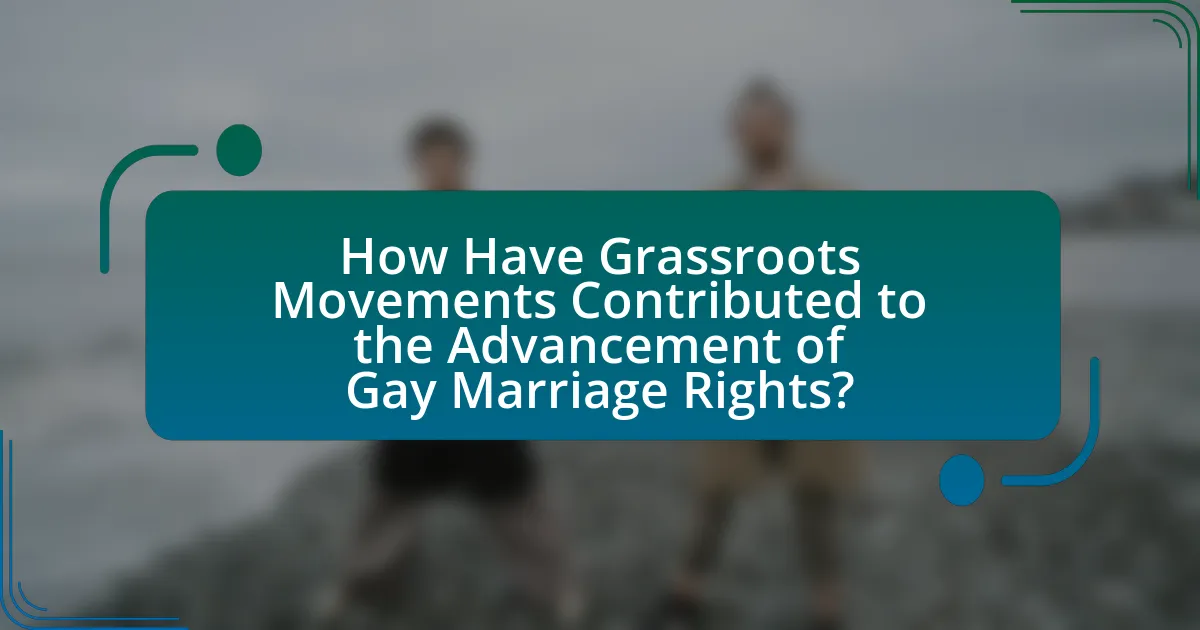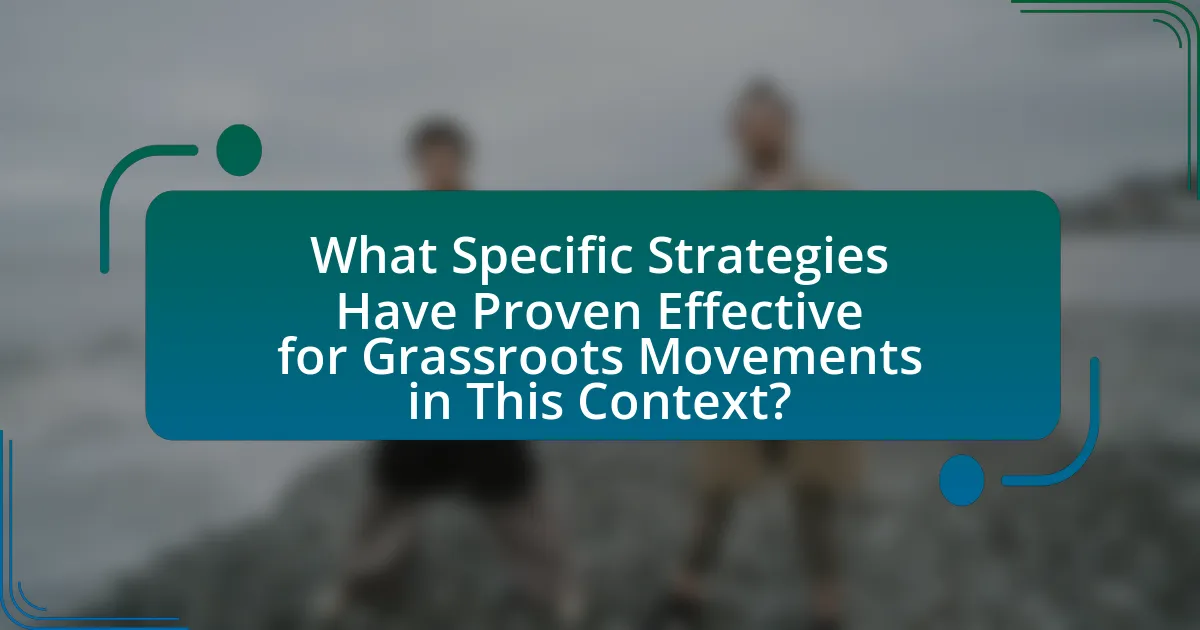Grassroots movements are organized efforts by ordinary individuals at the community level aimed at effecting social change, particularly in advocating for rights such as gay marriage. This article examines the significance of grassroots movements in advancing gay marriage rights, highlighting their strategies, such as community organizing, social media engagement, and coalition-building, which have mobilized public support and influenced legislative changes. Key historical examples, including the Stonewall Riots and the Supreme Court’s decision in Obergefell v. Hodges, illustrate the impact of grassroots activism on societal attitudes and legal frameworks. Additionally, the article discusses the challenges faced by these movements and the importance of intersectionality and partnerships in enhancing their effectiveness.

What are Grassroots Movements and Their Importance in Social Change?
Grassroots movements are organized efforts by ordinary people at the community level to effect social change, often focusing on issues that directly impact their lives. These movements are crucial for social change as they empower individuals to advocate for their rights, mobilize support, and influence public policy. For instance, the grassroots campaign for gay marriage rights in the United States, which gained momentum in the early 2000s, exemplifies how local activism can lead to significant legal and societal shifts, culminating in the Supreme Court’s decision in Obergefell v. Hodges in 2015 that legalized same-sex marriage nationwide. This case illustrates the effectiveness of grassroots movements in shaping public opinion and achieving legislative goals through sustained community engagement and advocacy.
How do grassroots movements function in advocating for rights?
Grassroots movements function in advocating for rights by mobilizing community members to collectively demand change and influence policy. These movements often utilize strategies such as organizing protests, leveraging social media for awareness, and building coalitions with other organizations to amplify their message. For instance, the Human Rights Campaign played a significant role in advancing gay marriage rights by engaging local communities, conducting educational campaigns, and lobbying lawmakers, which contributed to the legalization of same-sex marriage in multiple states prior to the nationwide ruling in Obergefell v. Hodges in 2015. This demonstrates how grassroots efforts can effectively shape public opinion and legislative outcomes.
What strategies do grassroots movements employ to mobilize support?
Grassroots movements employ strategies such as community organizing, social media engagement, and coalition building to mobilize support. Community organizing involves mobilizing local individuals to participate in advocacy efforts, which has been effective in increasing awareness and participation in campaigns for gay marriage rights. Social media engagement allows grassroots movements to reach a broader audience quickly, facilitating the sharing of personal stories and mobilizing supporters through platforms like Facebook and Twitter. Coalition building involves forming alliances with other organizations and groups, enhancing resources and visibility, as seen in the collaboration between LGBTQ+ organizations and civil rights groups during the push for marriage equality. These strategies have proven successful in rallying public support and influencing policy changes.
How do grassroots movements build community engagement?
Grassroots movements build community engagement by fostering local participation and mobilizing individuals around shared goals. These movements often utilize strategies such as organizing community events, facilitating discussions, and leveraging social media to raise awareness and encourage involvement. For instance, the Human Rights Campaign effectively engaged communities during the fight for gay marriage rights by organizing rallies and educational campaigns that brought people together, resulting in increased visibility and support for the cause. This approach not only empowers individuals but also creates a sense of belonging and collective action, which is crucial for sustaining long-term engagement in social movements.
Why are grassroots movements crucial for advancing social issues?
Grassroots movements are crucial for advancing social issues because they mobilize community members to advocate for change from the ground up. These movements often reflect the voices and needs of marginalized groups, enabling them to challenge systemic inequalities effectively. For instance, the grassroots campaign for gay marriage rights in the United States, which gained momentum in the early 2000s, demonstrated how local activism can influence national policy. According to a 2015 study published in the American Journal of Sociology, grassroots efforts significantly contributed to shifting public opinion on same-sex marriage, leading to the landmark Supreme Court decision in Obergefell v. Hodges, which legalized gay marriage nationwide. This illustrates that grassroots movements not only raise awareness but also create tangible legal and social advancements.
What historical examples illustrate the impact of grassroots movements?
Grassroots movements have significantly impacted the advancement of gay marriage rights, with notable examples including the Stonewall Riots of 1969 and the Marriage Equality movement in the early 2000s. The Stonewall Riots, sparked by a police raid at the Stonewall Inn in New York City, galvanized the LGBTQ+ community and led to the formation of various advocacy groups, such as the Gay Liberation Front, which pushed for equal rights and visibility. This event is often credited with igniting the modern LGBTQ+ rights movement, ultimately contributing to the legalization of same-sex marriage in many states.
Another key example is the grassroots efforts surrounding the 2004 same-sex marriage licenses issued in San Francisco by Mayor Gavin Newsom. This act of defiance against California law mobilized activists and supporters nationwide, leading to increased visibility and support for marriage equality. The sustained activism from grassroots organizations, such as the Human Rights Campaign and Freedom to Marry, played a crucial role in shifting public opinion and influencing legislative changes, culminating in the U.S. Supreme Court’s decision in Obergefell v. Hodges in 2015, which legalized same-sex marriage nationwide. These historical instances illustrate how grassroots movements have been pivotal in advancing gay marriage rights through mobilization, advocacy, and public engagement.
How do grassroots movements differ from traditional advocacy organizations?
Grassroots movements differ from traditional advocacy organizations primarily in their structure and approach to mobilization. Grassroots movements are typically community-driven and rely on local participation and activism, often emerging spontaneously from the needs and voices of individuals directly affected by an issue, such as the fight for gay marriage rights. In contrast, traditional advocacy organizations are usually more formalized, with established leadership, funding sources, and structured campaigns that may not always prioritize grassroots input. For instance, during the push for gay marriage legalization, grassroots movements like the Marriage Equality USA mobilized local communities to advocate for change, while organizations like the Human Rights Campaign operated with a more centralized strategy and resources. This distinction highlights how grassroots movements can foster a sense of ownership and urgency among participants, which can lead to more dynamic and responsive advocacy efforts.

How Have Grassroots Movements Contributed to the Advancement of Gay Marriage Rights?
Grassroots movements have significantly contributed to the advancement of gay marriage rights by mobilizing public support and influencing legislative change. These movements, such as the Human Rights Campaign and local advocacy groups, have organized protests, awareness campaigns, and educational initiatives that have shifted public perception towards greater acceptance of same-sex marriage. For instance, a 2015 Gallup poll indicated that support for same-sex marriage in the U.S. rose from 27% in 1996 to 60% in 2015, reflecting the impact of grassroots advocacy. Additionally, grassroots efforts played a crucial role in landmark legal cases, such as Obergefell v. Hodges, by providing personal stories and testimonies that highlighted the importance of marriage equality, ultimately leading to the Supreme Court’s decision to legalize same-sex marriage nationwide.
What key milestones have grassroots movements achieved in the fight for gay marriage?
Grassroots movements have achieved significant milestones in the fight for gay marriage, including the mobilization of public support, the establishment of legal precedents, and the influence on legislative changes. For instance, the 2004 Massachusetts Supreme Judicial Court ruling, which allowed same-sex marriage, was heavily influenced by grassroots advocacy, demonstrating the effectiveness of local activism. Additionally, organizations like the Human Rights Campaign and local LGBTQ+ groups have organized campaigns that led to increased visibility and support for marriage equality, culminating in the U.S. Supreme Court’s 2015 decision in Obergefell v. Hodges, which legalized same-sex marriage nationwide. These milestones reflect the critical role grassroots movements played in shaping public opinion and legal frameworks surrounding gay marriage.
How did grassroots movements influence public opinion on gay marriage?
Grassroots movements significantly influenced public opinion on gay marriage by mobilizing communities, raising awareness, and fostering personal connections through storytelling. These movements organized campaigns, rallies, and educational initiatives that highlighted the experiences of LGBTQ+ individuals, making the issue more relatable to the general public. For instance, the Human Rights Campaign’s “Love Conquers Hate” campaign effectively utilized social media to share personal stories, which contributed to a shift in public sentiment; a Gallup poll indicated that support for same-sex marriage rose from 27% in 1996 to 70% in 2021. This increase in acceptance can be attributed to the persistent efforts of grassroots organizations that engaged in direct dialogue and advocacy, thereby normalizing the conversation around gay marriage and influencing legislative outcomes.
What role did grassroots movements play in landmark legal cases?
Grassroots movements played a crucial role in landmark legal cases by mobilizing public support, influencing political discourse, and directly advocating for legal changes. For instance, the grassroots efforts of organizations like the Human Rights Campaign and local LGBTQ+ groups were instrumental in shaping public opinion and creating a climate conducive to legal challenges against discriminatory laws. These movements organized protests, educational campaigns, and lobbying efforts that highlighted the need for marriage equality, ultimately contributing to significant legal victories such as the Supreme Court’s decision in Obergefell v. Hodges in 2015, which legalized same-sex marriage nationwide. The sustained activism and visibility created by grassroots movements were essential in demonstrating widespread support for marriage equality, thereby impacting judicial outcomes.
What challenges have grassroots movements faced in advocating for gay marriage rights?
Grassroots movements advocating for gay marriage rights have faced significant challenges, including legal opposition, societal stigma, and resource limitations. Legal opposition has manifested in the form of state-level bans and constitutional amendments that explicitly prohibit same-sex marriage, such as the Defense of Marriage Act enacted in 1996, which hindered progress. Societal stigma has created an environment of discrimination and hostility, making it difficult for grassroots organizations to mobilize support and engage communities effectively. Additionally, resource limitations, including funding and access to media platforms, have restricted the ability of these movements to reach broader audiences and sustain long-term campaigns. These challenges have collectively impeded the effectiveness of grassroots efforts in advancing gay marriage rights.
How have opposition groups responded to grassroots efforts for gay marriage?
Opposition groups have responded to grassroots efforts for gay marriage by mobilizing campaigns to counteract these movements. For instance, organizations such as the National Organization for Marriage have actively worked to promote legislation and ballot measures aimed at defining marriage as a union between one man and one woman. Additionally, these groups have utilized media campaigns to disseminate their viewpoints, often framing the issue in terms of traditional values and religious beliefs. This response has included significant financial contributions to anti-gay marriage initiatives, as seen in various states where opposition groups have successfully influenced public opinion and policy through targeted outreach and advocacy efforts.
What internal challenges do grassroots movements encounter?
Grassroots movements encounter several internal challenges, including lack of cohesion, resource limitations, and leadership conflicts. Lack of cohesion often arises from diverse viewpoints within the movement, which can lead to fragmentation and diluted messaging. Resource limitations, such as insufficient funding and volunteer support, hinder the ability to mobilize effectively and sustain long-term efforts. Leadership conflicts can create power struggles, undermining the movement’s unity and focus. For instance, a study by the Movement Advancement Project highlights that internal divisions can weaken advocacy efforts, making it difficult to present a united front in the fight for gay marriage rights.

What Specific Strategies Have Proven Effective for Grassroots Movements in This Context?
Grassroots movements have effectively utilized community organizing, social media campaigns, and coalition-building to advance gay marriage rights. Community organizing has mobilized local supporters, creating a strong base for advocacy, as seen in the early efforts of organizations like the Human Rights Campaign, which engaged volunteers to raise awareness and support. Social media campaigns have amplified messages and connected individuals across regions, exemplified by the viral spread of the “Love Wins” hashtag following the Supreme Court’s decision in Obergefell v. Hodges in 2015, which solidified public support. Coalition-building has united diverse groups, including LGBTQ+ organizations, civil rights advocates, and faith communities, enhancing the movement’s reach and impact, as demonstrated by the collaboration between groups like Freedom to Marry and various local activists. These strategies collectively contributed to significant legislative and societal changes regarding gay marriage rights.
How do grassroots movements utilize social media to promote gay marriage rights?
Grassroots movements utilize social media to promote gay marriage rights by creating awareness, mobilizing supporters, and facilitating communication. These movements leverage platforms like Facebook, Twitter, and Instagram to share personal stories, educational content, and calls to action, effectively reaching a broad audience. For instance, the Human Rights Campaign’s #LoveWins campaign on social media played a significant role in raising visibility and support for marriage equality, contributing to the Supreme Court’s decision in Obergefell v. Hodges in 2015, which legalized same-sex marriage nationwide. This demonstrates how social media serves as a powerful tool for grassroots organizations to influence public opinion and policy regarding gay marriage rights.
What platforms have been most effective for grassroots mobilization?
Social media platforms, particularly Facebook and Twitter, have been most effective for grassroots mobilization. These platforms enable rapid information dissemination, community building, and engagement among supporters. For instance, during the campaign for marriage equality in the United States, Facebook groups and Twitter hashtags like #LoveWins played crucial roles in organizing events, sharing personal stories, and rallying public support, contributing to the eventual Supreme Court decision in Obergefell v. Hodges in 2015, which legalized same-sex marriage nationwide.
How do grassroots movements create compelling narratives to engage supporters?
Grassroots movements create compelling narratives to engage supporters by leveraging personal stories and shared experiences that resonate emotionally with the audience. These narratives often highlight the struggles and triumphs of individuals affected by issues related to gay marriage rights, making the cause relatable and urgent. For instance, movements like the Human Rights Campaign have effectively used personal testimonials from same-sex couples to illustrate the real-life impact of marriage inequality, thereby fostering empathy and a sense of community among supporters. This strategy not only humanizes the issue but also mobilizes individuals to take action, as evidenced by increased participation in rallies and advocacy efforts following emotionally charged campaigns.
What role does coalition-building play in the success of grassroots movements?
Coalition-building is essential for the success of grassroots movements as it amplifies collective power and resources. By uniting diverse groups with shared goals, grassroots movements can leverage a broader base of support, increase visibility, and enhance their advocacy efforts. For instance, the coalition of various LGBTQ+ organizations during the fight for gay marriage rights in the United States, such as the Human Rights Campaign and Lambda Legal, demonstrated how collaboration can lead to significant legislative victories, including the landmark Supreme Court decision in Obergefell v. Hodges in 2015, which legalized same-sex marriage nationwide. This coalition not only mobilized grassroots activism but also secured funding, media attention, and political influence, proving that coalition-building is a critical strategy for achieving meaningful change in social movements.
How do partnerships with other organizations enhance grassroots efforts?
Partnerships with other organizations enhance grassroots efforts by providing additional resources, expertise, and networks that amplify the impact of local initiatives. For instance, collaborations with established advocacy groups can offer financial support, strategic guidance, and access to broader audiences, which are crucial for mobilizing community engagement. A notable example is the collaboration between grassroots organizations and national LGBTQ+ rights groups during the campaign for marriage equality, where shared resources and coordinated messaging significantly increased visibility and support, leading to successful legislative changes in various states. This synergy not only strengthens grassroots movements but also fosters a unified front that can effectively challenge systemic barriers.
What are the benefits of intersectionality in grassroots movements for gay marriage?
Intersectionality in grassroots movements for gay marriage enhances inclusivity and broadens support by recognizing the diverse identities and experiences within the LGBTQ+ community. This approach allows movements to address the unique challenges faced by individuals at the intersections of race, gender, class, and sexual orientation, thereby fostering solidarity among various marginalized groups. For instance, research by Crenshaw (1989) highlights how intersectional frameworks can lead to more effective advocacy strategies that resonate with a wider audience, ultimately strengthening the movement’s impact. By integrating intersectionality, grassroots efforts can mobilize a more diverse coalition, ensuring that the fight for gay marriage rights is not only about legal recognition but also about social justice and equity for all.
What practical steps can individuals take to support grassroots movements for gay marriage rights?
Individuals can support grassroots movements for gay marriage rights by actively participating in local advocacy efforts, such as attending rallies and community meetings. Engaging in these activities helps raise awareness and mobilizes support for the cause. Additionally, individuals can contribute financially to organizations that focus on LGBTQ+ rights, as funding is crucial for sustaining grassroots initiatives. Volunteering time and skills to these organizations can also amplify their impact, whether through organizing events, providing legal assistance, or helping with outreach efforts. Furthermore, individuals can use social media platforms to share information and promote campaigns, thereby increasing visibility and encouraging others to join the movement. Research indicates that grassroots movements have been instrumental in advancing social change, as seen in the successful campaigns for marriage equality in various countries, highlighting the effectiveness of community-driven efforts.


